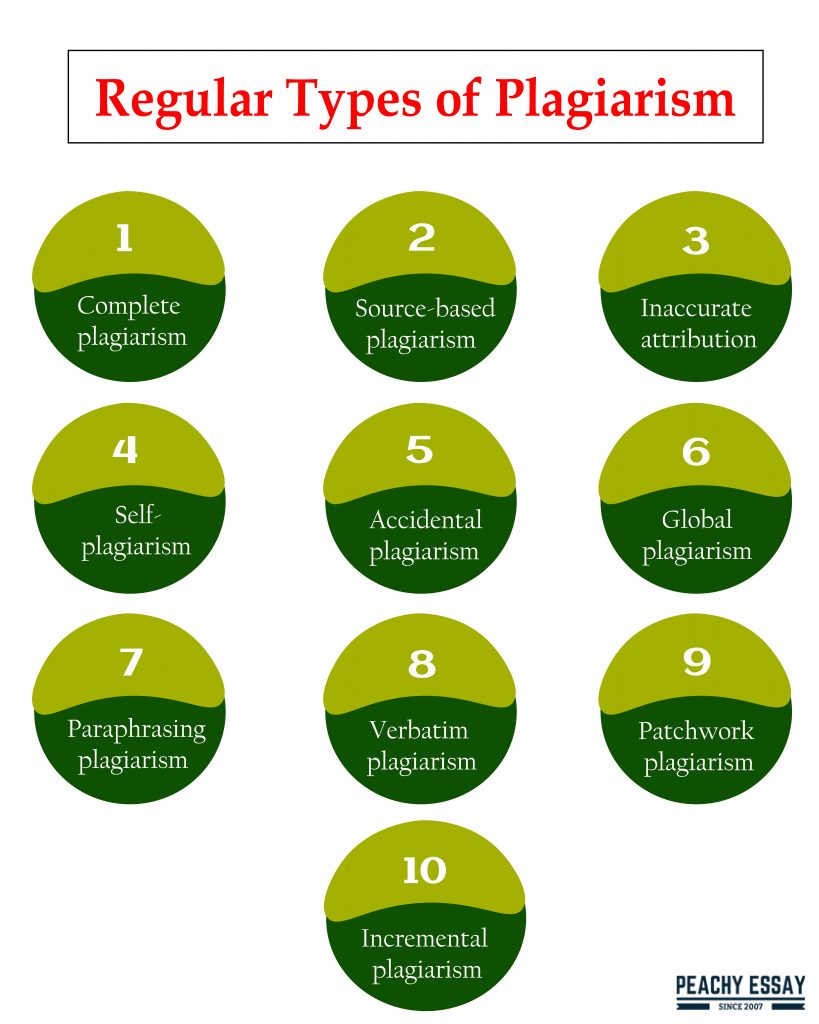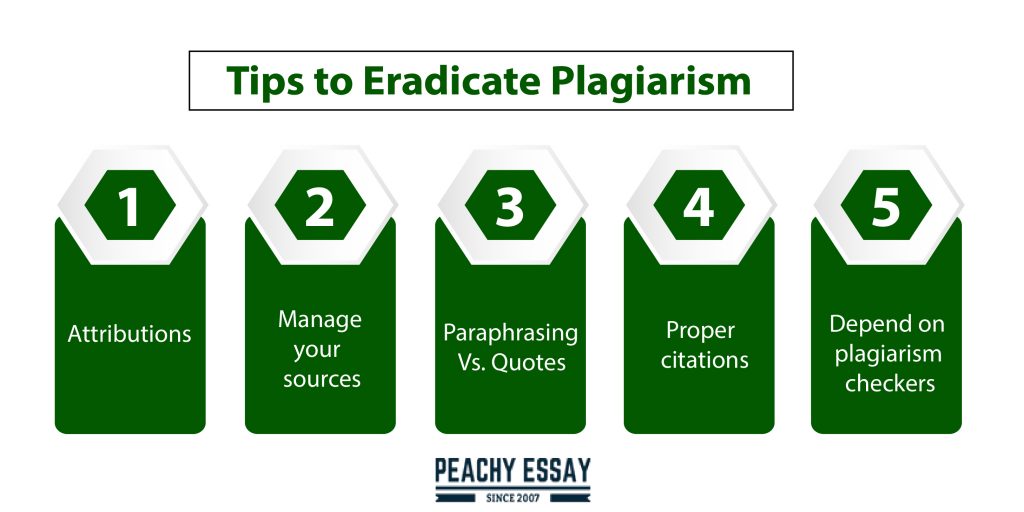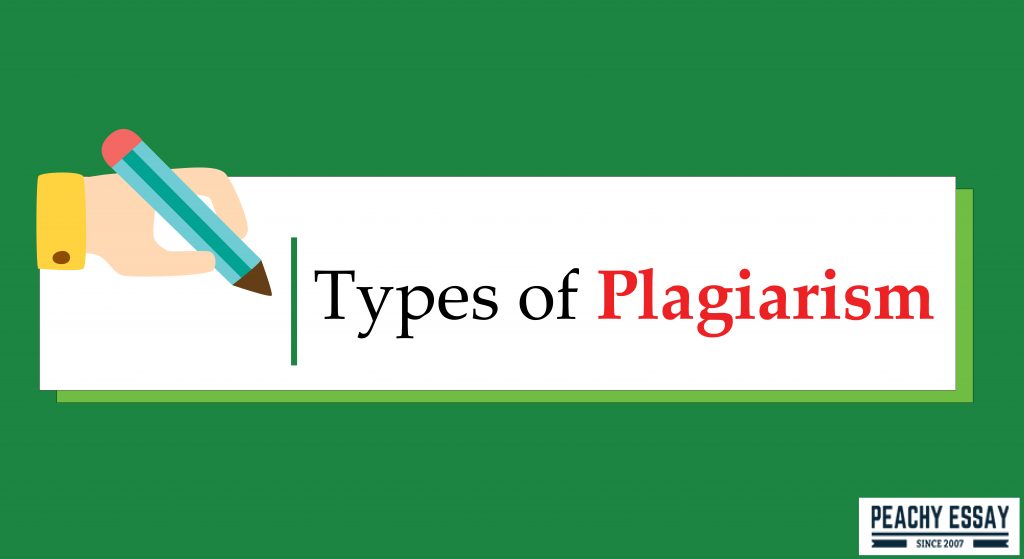Plagiarism is the exercise of using another person’s work as your own without attributing the source. There are many different ways you can commit this offence. All of these plagiarism types, regardless of their intensity, come with penalties or legal actions.
Be careful not to commit any of them. If you are not familiar with the different forms of plagiarism, this article will help you out. It will list the most typical mistakes alongside the less common ones you need to avoid in your academic writing.
Common Types of Plagiarism
There exist multiple types of plagiarism. They occur differently, and it would be wise to know these common types of plagiarism and how they happen. Let us go through them.

-
Complete plagiarism
Complete plagiarism leads our list. The commonest cheating that students fall into and result in severe penalties like suspension or expulsion from school. It occurs when a student or researcher takes someone’s script, alters the student’s details, and submits it without modifying the content.
-
Source-based plagiarism
Source-based plagiarism happens when there is misleading information on the sources or citations. For example, you might be liable for this offense when you attach the wrong sources in your research paper.
Also, this type of plagiarism occurs when you fail to include secondary sources in your references, yet you used its information. Do not put the primary sources alone. Include your secondary sources too.
Falsifying or fabricating your data are also forms of source-based plagiarism. Information fabrication is all about faking your sources and findings. Data falsification means altering or leaving out information for the wrong impression. When found with the source-based plagiarism offence, you might fave harsh legal actions. For instance, when dealing with medical reports, you might endanger lives with false information.
-
Inaccurate attribution
Inaccurate attribution might occur in different common ways.
In one way, it can happen when a student puts effort into research work but does not solid attribution. The other way is the vice versa of the first instance. You commit inaccurate attribution plagiarism when you get credit in a research paper but did not contribute to it.
All of the ways violate your school regulations and the general research laws. So, you will be punished for it.
You might also commit this offence when you allow someone else to edit your work, which leads to substantial changes. We shall look into how to avoid this offence later in this article.
-
Self-plagiarism
Also referred to as auto plagiarism or duplication, it is a form of plagiarism that occurs when a writer uses solid sections of his previously published work in his new research without proper attribution.
Self-plagiarism is more prevalent among research individuals than academic students – institutions are still discussing the gravity of its penalty. It will depend on the amount of the duplicated content. However, the majority of the research institutions have criteria and policies on the percentage of information that you can reuse. Journals today are utilizing plagiarism checker tools to test the work’s uniqueness.
-
Accidental plagiarism
Whether done out of pure intentions or unawareness, plagiarism comes with legal actions. However, sometimes, cheating on your thesis might be accidental due to negligence or unintentional rephrasing of your words.
Students are more likely to fall under this plagiarism category. It would be helpful for universities and colleges to empower their students on accidental plagiarism to avoid getting into trouble.
There are other different types of plagiarism that the article will discuss. Let us check on them below attentively.
-
Global plagiarism
Global plagiarism is another common type of plagiarism similar to the complete form of cheating. You take someone’s else whole work and submit it to your professor as your own. If you look for a random article online and submit it to your supervisor, you might be committing global plagiarism.
Most times, students do not credit the relevant authors when forwarding such type of work. The cheating is done deliberately, and you should therefore expect heavy penalties with the relative legal actions.
-
Paraphrasing plagiarism
Paraphrasing plagiarism is another common form of cheating. Paraphrasing in layman’s language means altering phrases and sentence structures without losing the solid meaning. In a plagiarism context, paraphrasing uses someone’s work, modifying the words and making your content.
The sentence structure may come out differently, but the primary idea is still there. That is ideally cheating. Paraphrasing is even a more serious offence when you do not attribute the original author in writing.
-
Verbatim plagiarism
Direct plagiarism is another word you can use for this type of cheating. It happens when a student or a researcher uses exact words of someone’s else work – and fails to use quotation marks or proper author’s credits. When you use someone’s word by word in your research paper and submit it as yours, you commit verbatim plagiarism.
It is pretty similar to complete plagiarism. But for this cheating, you only use sections of someone’s else work and not all. Students who commit this cheating end up in disciplinary actions due to their assignment dishonesty. Verbatim plagiarism is not well-known but can land you serious legal actions.
-
Patchwork plagiarism
Patchwork or mosaic plagiarism is a form of cheating where a student uses phrases from someone else work with no quotation marks. Or, it can happen in a way that a researcher relies on synonyms to replace the plagiarised content while maintaining the structure and meaning of the other author’s work.
The offence comes up when you do not paraphrase your work well. Students who commit patchwork plagiarism mostly do it unintentionally. It combines copy-paste and the find-replace techniques. Even though mosaic plagiarism is done out of intent, it is punishable in learning and research institutions.
-
Incremental plagiarism
You indulge in incremental plagiarism when you use someone’s speech phrase in your speech. A high population of individuals does not quite understand this plagiarism act. Most of those individuals who get offended by this act are because they are not aware of it.
Incremental plagiarism leads to poor reputation and affects one credibility. You could escape plagiarism penalties during the earlier years. With the advancement of technology today, it might be challenging to get away with it. There are multiple ways with an online tool to beat down plagiarism.
Other Types of Plagiarism
Other forms of plagiarism are not pretty common. They might include:
-
Hired plagiarism
Most times, individuals who commit this offence have someone else to do their work for them. Also, other students decide to purchase assignments online from a variety of writing services.
Some learning institutions might consider plagiarism when you sign a contract with third parties to deal with your assignment.
-
Collaboration plagiarism
This type of plagiarism involves research individuals working together on a project who presented their work as their own. You commit collaboration plagiarism when you submit a plagiarised group assignment.
-
Minimalistic plagiarism
It is a form of paraphrasing plagiarism where a writer makes minimal changes to the phrases of a source. It might be difficult for plagiarism checkers to detect minimalistic plagiarism.
-
Outline plagiarism
The offence takes place when you use the same outline as another author’s content. But still, utilise similar content. You can call it retweet plagiarism – it uses someone’s essay or relevant type of writing. Most times, the sources are original, but the information content might be the same.
Avoid All Types of Plagiarism
Now we are aware of the different types of plagiarism. It might be easier to avoid them. Here are the pro tips on how to eradicate plagiarism in your research paper.

- Attributions
Acknowledge all contributors to your research paper. It is disrespectful to leave out an author or editor when publishing your work. By doing so, you will not fall an offender of inaccurate attribution plagiarism.
- Manage your sources
Putting your phrases and sentence structures right would be wise to be cautious as you handle your write-up. While doing your research, pay attention to your notes. They will come in handy while compiling the final draft of your research.
Always ensure to include all sources in your work. Most plagiarism cases are due to leaving out citations. It would be helpful to organize your content well not to become a plagiarist.
- Paraphrasing Vs. Quotes
You can easily eradicate plagiarism by following through these two techniques; paraphrasing and quotations. Most individuals might vote for paraphrasing over the use of quotes. It favors writers while handling more lengthy paragraphs. On the bright side, it might assist you with having an incredible grasp of the content.
Your work also becomes more original. On the other hand, quotation comes in handy while using the exact words of the source.
- Proper citations
The use of citations is the ultimate way of solving the dishonest authorship plagiarism act. It would be best to include in-text citations while working on your write-up. Most times, it constitutes the publication year and the relative page number.
Remember to include a reference list in the footnote of your document. It will help the readers to reach these sources with less hassle.
- Depend on plagiarism checkers
The growth of technology has assisted institutions in relying on online plagiarism tools to test the uniqueness of their students’ work. The software allows you to scan your documents and eventually reveal the plagiarism scores. Also, your content is compared against billions of websites and library repositories.
Most of these plagiarism checkers highlight the plagiarized content in your file and provide guidelines to solve the issue.
It would be wise to run your work through a plagiarism tool of choice after completing the writing. The software uses modern technologies that assist in shunning plagiarism cases.
Best writers know how to eradicate plagiarism offences. Repeatedly go through this list to have a smooth writing experience.
Who Can Help to Avoid Plagiarism?
Plagiarism is not a good trait for any researcher or student. It portrays unseriousness in this particular type of individual. Be it intentional or unintentional. Make sure to cite all sources correctly or become a criminal.
When you take someone’s else phrases or sentence structures might make be out of school. Reference your sources effectively and complete your high school or bachelor’s studies. If you get someone else to do the work for you, choose a reliable and legitimate writing service—one that will ensure 100% originality in your thesis or dissertation paper.
Frequently Asked Questions
If I alter the phrases, do I need to cite the sources?
It is not good enough to prevent plagiarism acts by including sources in your writing. It would be helpful to cite your sources to ensure that you will not be charged with plagiarism.
Even if I cite my sources, can I become a plagiarist?
There is no crime when you borrow someone else ideas and thoughts. However, you need to effectively give them credits and comply with the set institution laws. If you use someone’s exact words, you might become a plagiarist. IT would be pretty good to use quotation marks while utilising someone’s else content.
If I write something, somebody else already published, but I didn’t know they wrote it, is that still plagiarism?
It is possible to have similar ideas with someone else. However, the sentence structures and phrases might differ in some way. It might be impossible to become a plagiarist if you are offended by duplicating the content of an author whom you have never come across.
Be careful not to commit accidental plagiarism. Cite every source that you use to avoid being guilty of a plagiarism act.
Why is it crucial to understand the different types of plagiarism?
Being aware of the different forms of plagiarism comes with solid privileges. It assists you with knowing the existing varieties. Therefore, they help eradicate the challenge and its legal penalties.
What types of plagiarism exist?
There are many different types of plagiarism. The popular ones include global, verbatim, paraphrasing, and accidental plagiarism.
What are some of the plagiarism offences?
Plagiarism penalties might expel you from school. Also, you might fail your course program.




